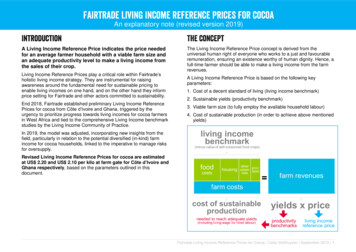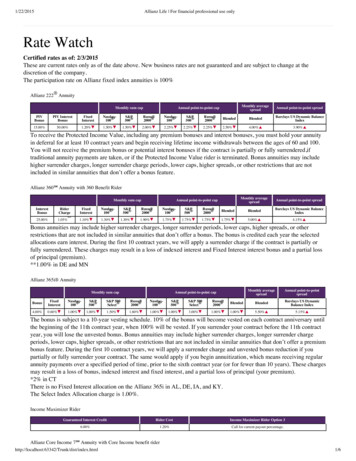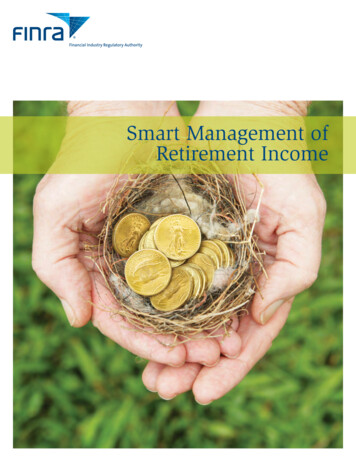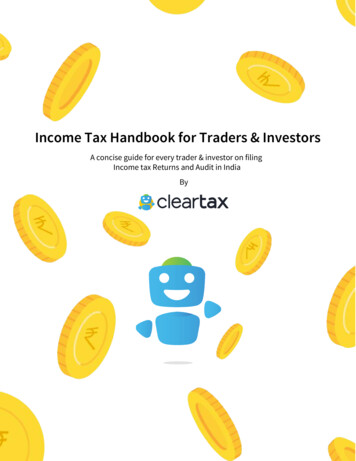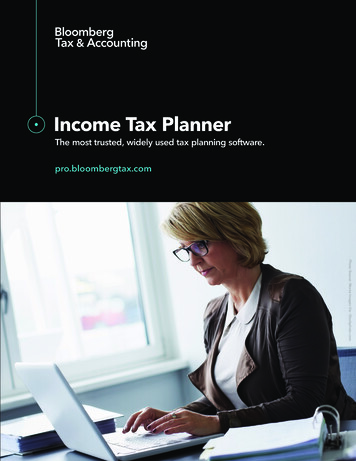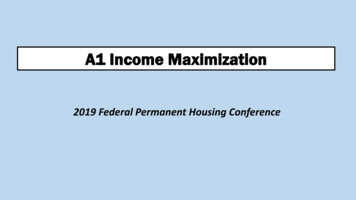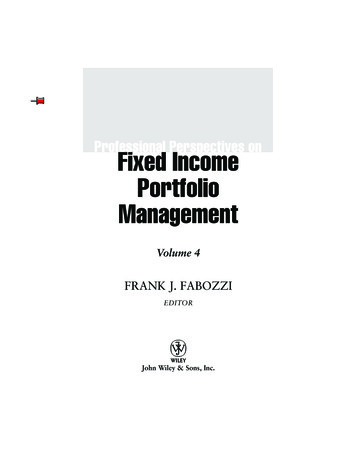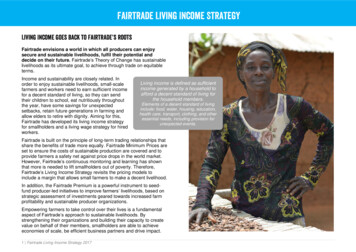
Transcription
Fairtrade Living Income StrategyLiving Income goes back to Fairtrade’s rootsFairtrade envisions a world in which all producers can enjoysecure and sustainable livelihoods, fulfil their potential anddecide on their future. Fairtrade’s Theory of Change has sustainablelivelihoods as its ultimate goal, to achieve through trade on equitableterms.Income and sustainability are closely related. Inorder to enjoy sustainable livelihoods, small-scalefarmers and workers need to earn sufficient incomefor a decent standard of living, so they can sendtheir children to school, eat nutritiously throughoutthe year, have some savings for unexpectedsetbacks, retain future generations in farming andallow elders to retire with dignity. Aiming for this,Fairtrade has developed its living income strategyfor smallholders and a living wage strategy for hiredworkers.Living income is defined as sufficientincome generated by a household toafford a decent standard of living forthe household members.Elements of a decent standard of livinginclude: food, water, housing, education,health care, transport, clothing, and otheressential needs, including provision forunexpected events.Fairtrade is built on the principle of long-term trading relationships thatshare the benefits of trade more equally. Fairtrade Minimum Prices areset to ensure the costs of sustainable production are covered and toprovide farmers a safety net against price drops in the world market.However, Fairtrade’s continuous monitoring and learning has shownthat more is needed to lift smallholders out of poverty. Therefore,Fairtrade’s Living Income Strategy revisits the pricing models toinclude a margin that allows small farmers to make a decent livelihood.In addition, the Fairtrade Premium is a powerful instrument to seedfund producer-led initiatives to improve farmers’ livelihoods, based onstrategic assessment of investments geared towards increased farmprofitability and sustainable producer organizations.Empowering farmers to take control over their lives is a fundamentalaspect of Fairtrade’s approach to sustainable livelihoods. Bystrengthening their organizations and building their capacity to createvalue on behalf of their members, smallholders are able to achieveeconomies of scale, be efficient business partners and drive impact.1 Fairtrade Living Income Strategy 2017
Fairtrade Living Income StrategyFairtrade Living Income StrategyThe Fairtrade living income roadmapThe general objective of Fairtrade’s Living Income Strategy is tocreate an enabling environment and develop tools that supportFairtrade certified smallholders to progress towards a livingincome. Making progress towards a living income means bridging thegap between current farmer incomes and a living income.Farmers who do not earn the net incomeneeded to provide a decent livelihood fortheir family are unable to reinvest intheir farms. Thereforethey cannot upholdadequateproductivitylevels, causingyields to decline(or remain low).As aconsequence,the farmer getstrapped in avicious circle ofpoverty.At the same time,farm revenueswon’t allow adecent pay forhired farmworkers and thenext generationwill opt for moreprofitable ways ofmaking a living ifthey get a chance,abandoning the inviablefarms altogether.2 Fairtrade Living Income Strategy 2017In order to make significant progress towards living income and invertthe poverty trap for smallholders, a holistic approach is required.Higher farm revenues can be obtained through: sustainable pricing,increased sales on Fairtrade terms, increased farm yields fromsustainable agriculture and adding value. Costs can be reducedthrough improving efficiencies at farm and at organizational level. Anenabling environment can be created through advocacy action.A combination of these pathways, tailored tothe particularities of each commodity andregion, will form bespoke roadmapsto improve farmers’incomes.As incomes ofsmallholderfarmers increase,a path is enabledto improve thewell-being of allfamily members,as well as theconditions of theworkers theyemploy on theirfarms.This way, livingincomes make itpossible tomitigateunacceptablelabour practices,such as childlabour, and forentire communities toprosper.
Fairtrade Living Income StrategyFairtrade Living Income StrategyA living income baselineA farmer household income is usually made up of several farm andoff-farm income sources. The Fairtrade Living Income Strategy focusis limited to the cash and in-kind farm income. However, in order to setrealistic goals, Fairtrade has defined a set of basic conditions bywhich Fairtrade farmers would be expected to make a livingincome from farm revenues alone.figure 2: The income needed to afford a decent standard of living is in principle thesame for an average worker household as for a farmer household in the same region.To calculate a living wage, he total household income needs are divided by theaverage number of breadwinners in the household. Similarly, a farmer who works fulltime on his or her farm should make the equivalent of a living wage, which can beexpressed as a living income per farmer household member who is fully engaged infarm work. The income per full time equivalent (FTE) breadwinner, whether employedas a wage earner or working on his/her own farm, should therefore be the same.figure 1: The cost elements of a basic, decent living for a typical rural household andthe possible sources of income to meet these needs.yields: Adequate productivity levels are determined based on feasibleyields, obtained when implementing environmentally sustainableagricultural practices. These productivity benchmarks are to beestablished per commodity and region.The main variables influencing farm income are: farm size, yields andprice received for the produce. As a baseline for living incomecalculations, the following key parameters are established:price: The price received for a Fairtrade crop should allow an averagefarmer household with a full-employment farm size and an adequateproductivity level to earn a living income when selling on fair tradingterms.farm size: Drawing a parallel with living wages (see figure 2), whichare calculated on the basis of the average number of breadwinners ina household, a living income for a rural household would also take thenumber of adult family members working on the farm into account.Following this logic, a farm that is big enough to fully absorb theavailable household labour force, should be able to generate a livingincome. This will be called a “full-employment farm size”.3 Fairtrade Living Income Strategy 2017farm diversification: Crop diversification is recommended as astrategy to improve farm and income resilience. A proportionate shareof a living income would be generated from the part of the farmdedicated to the Fairtrade crop.
Fairtrade Living Income StrategyFairtrade Living Income Strategy1. Sustainable pricingFairtrade’s living income ambitionLiving incomes will be achieved by average Fairtradesmallholder families with at least a full-employmentfarm size and an adequate productivity level, who selltheir Fairtrade crop on fair trading terms. Living income reference prices will be calculated based onthese parameters, and will guide Fairtrade’s price-settingmechanisms. A business case for supply chain commitment will be builtaround the human right to a living income, which can beachieved when the living income reference price is paid. Producer support programmes and Fairtrade Premiuminvestment planning guidelines will be developed, enablingfarmers to reach adequate sustainable productivity andefficiency levels.Objective: Fairtrade Living Income References Prices are set, asa benchmark for Fairtrade sustainable pricing models. Fairtrade Living Income References Prices will be calculatedbased on the gap between living income benchmarks and actualhousehold incomes when baseline parameters are met. Householdincome and productivity research will provide the data needed todetermine the baseline parameters of “full-employment farm size”and “feasible yields” per commodity and region. The net farm income is the sum of farm revenues (in cash and kind)minus the cost of sustainable production. The cost of sustainableproduction will include the cost of a fair remuneration of hiredlabour on smallholder farms. Hence, the living income referenceprice would cover both a living income for the farmer household aswell as a living wage for hired workers. The cost of sustainableproduction will also include a risk margin as a buffer for calamities. Living income benchmarks will be consistent with living wagebenchmarks, considering a compensation for sick and paid leavefor self-employed farmers. Different mechanisms of implementing the living income referenceprice (i.e. through Fairtrade Minimum Prices, Premiums orseparate income funds) will be assessed and are likely to beproduct/supply chain specific. An increase in the price paid to the producer escalates each timethe product changes hands, translating into an exponential priceincrease to the end consumer, which leads to the product losing itscompetitiveness. Mechanisms to by-pass price/margin escalationacross the supply chain will therefore be explored to avoid this. Since Fairtrade prices are paid to the producer organization andthe share that is paid out to the individual farmer membersdepends partly on the efficiency of the organization, there is aremaining challenge to convert the price calculated at farmer levelto a sustainable price at organizational level. This ambition will be used for advocacy positioning andpublic awareness messaging.The above ambition statement outlines a viable roadmap towardsachieving living incomes for smallholder farmers, but it also reflectsconditions which might limit Fairtrade’s effective impact.The full intended impact of establishing price levels by which farmerscan make a living income will only materialize when the crops areeffectively sold at the reference price, and sufficient yields areobtained, and the farmer family members actually work on their farm.The actual income result will therefore be proportionate to the sales onFairtrade terms, productivity level achieved and the percentage of theavailable household labour employed. Moreover, the income sharefrom Fairtrade sales will be proportionate to the area of the farmdedicated to this crop.4 Fairtrade Living Income Strategy 2017
Fairtrade Living Income StrategyFairtrade Living Income Strategy2. Fairtrade sales growth4. Farm cost efficiencyObjective: Existing and new Fairtrade commercial partnerscommit to improve farmers’ incomes through paying theFairtrade living income reference price, increasing Fairtrade salesvolumes and investing in complementary programmes.Objective: Fairtrade producers are able to calculate theirproduction costs and make informed business decisions toimprove the profitability of their farms. Key commercial stakeholders will be engaged at an early stage tojointly explore actions for improving farmers’ incomes and seeksupply chain commitments to make progress on living income. Incentives for businesses to act in support of living income at originwill be developed, by building the business case for sustainablesupply and responsible sourcing, showcasing positive action andrewarding firm commitments.3. Sustainable farm yields Managing a farm as a small-scale enterprise requires an adequateunderstanding of the cost of production to begin with. Appropriatefarmer-friendly tools will be developed, based on current tools forcollecting costs of sustainable production data, for smallholders tocalculate their production costs and retrieve indications on how toincrease their yields. Such tools could feed into a central Information ManagementSystem at organizational level, allowing technical and commercialdepartments to trace their plans and develop productivityenhancement programmes based on real data. Enhanced producer capacity to provide accurate data on cost ofproduction will in turn strengthen Fairtrade price reviewingprocesses as well as producers’ bargaining position towardsindustry partners.Objective: Fairtrade producers reach adequate sustainableproductivity levels and enhance farm resilience. Better yields can be obtained from enhanced productivity,improved quality and adding value on one hand, while pursuingfarm resilience on the other, by implementing sustainableagricultural practices and fostering product diversification and foodsecurity.Appropriate yield improvement programmes will be developedbased on best practice and proven effectiveness of existinginitiatives, and implemented in partnership with experienced andwell-equipped local organizations. Farm diversification opportunities will be explored as a strategy togenerate additional income and improve livelihood resilience. Facilitating access to the financial resources for making therequired farm investments needs to be part of yield improvementprogrammes, to ensure adequate adoption rates. The use of theFairtrade Premium as seed funding will be encouraged.5 Fairtrade Living Income Strategy 20175. SPO efficiencyObjective: Fairtrade Small Producer Organizations (SPOs) areefficient, sustainable social enterprises with good governancepractice and adequate business management capacity tooptimize value creation for their members. Organizational development is of vital importance to ensureinternal coherence, efficient and effective business performanceand resilience to external risks. This is needed to become viableand sustainable social enterprises, optimize the use of theirresources and generate meaningful value for their members. Well-managed organizations are recognized as reliable businesspartners and have a stronger bargaining position to negotiate
Fairtrade Living Income StrategyFairtrade Living Income Strategyfavorable terms of contracts, while gaining better access tomarkets. Similarly, producer organizations are eligible for loans when theycan show good governance, viable business plans and haveproper financial management procedures in place. Timely accessto finance is crucial for SPOs to execute their plans: Whether theyneed to invest in infrastructure, renovation programmes orimplement other cost reducing measures or whether theyprefinance farm investments of their members to improve theirproductivity, without financial resources none of this canmaterialize.Fairtrade SPO standards are currently under review to betterreflect living income considerations, and strengthen them as aninstrument that enables SPOs to develop their full potential.7. Enabling environmentObjective: The importance of fair and effective market systems todeliver living incomes is recognized and acted upon bygovernments, policy makers and companies as a result ofadvocacy. Advocacy should lead to the implementation of measures thataddress the imbalances of power in supply chains that obstructprogress towards living incomes. Influencing can take place at different levels, including globalcommodity forums; governments of consumer countries, atregional level (e.g. EU) or at origin. Windows of opportunity foradvocacy action will be further identified. Hard data on living income gaps are needed to support tradepolicy and business regulation advocacy at international level orfor lobbying for better access to services and infrastructure at alocal level. Different ways to obtain living income benchmarks willbe explored. The living income strategy is embedded in Fairtrade’s Theory ofChange and a specific set of impact evaluation indicators at farmerhousehold level will be established for monitoring progresstowards reaching living income levels for Fairtrade small-scaleproducers. In collaboration with Fairtrade’s Monitoring, Evaluation& Learning team, tools and a methodology for generating andanalysis of monitoring data will be developed.6. Strategic Premium useObjective: Fairtrade Premium is invested strategically by SPOs,contributing to the accomplishment of their long-term goals,prioritizing organizational and livelihood sustainability. The Fairtrade Premium can be instrumental for achievingorganizational sustainability, enabling SPOs to manage theirbusiness efficiently on behalf of their members and to resourceproducer-led initiatives, geared towards increased farm profitabilityand sustainable livelihoods for farmer and worker families. An SPO has to secure its long term viability, before it caneffectively serve its members and the surrounding communities,since it is the business that generates the means to pursue itsgoals. Premium planning guidance is being developed to strengthen thestrategic planning capacity of SPOs, and support internal decisionmaking processes for strategic premium use.6 Fairtrade Living Income Strategy 2017The Fairtrade Living Income Strategy is an evolving approach, in whichnew learnings and early results from pilot implementation projects will beincorporated to continuously improve the model and optimize its impact.For further information and updates, please contact: Carla Veldhuyzen,Sr. Advisor SPO development, at c.veldhuyzen@fairtrade.net.
Oct 23, 2017 · Living incomes will be achieved by average Fairtrade smallholder families with at least a full-employment farm size and an adequate productivity level, who sell their Fairtrade crop on fair trading terms. Living income reference prices will be calculated based on these paramet
